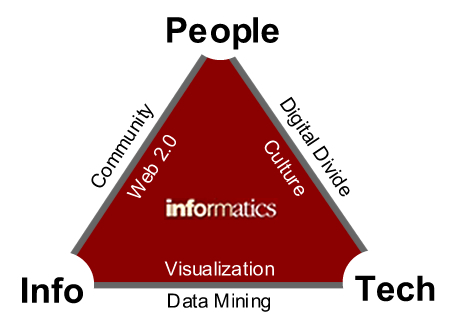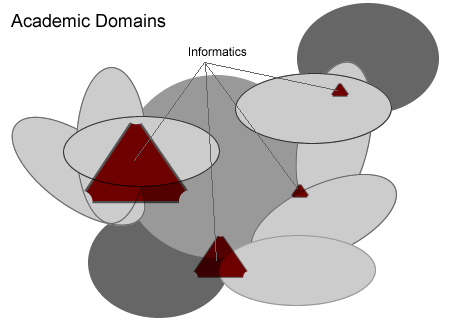We get asked that question a lot. By friends, by family members, by businesses. The question came up again in the Ph.D. pedagogy course this week. The truth is, there is no single definition. Even in places where it has been in vogue for years, like Scandinavia and Korea, the term is applied in disparate ways. If you ask the faculty and administrators at the IU School of Informatics, it is up to the doctoral students—as the first group of academics with a degree in the field—to address the problem of definition.
For two years of Masters work, defining informatics was personal journey. One was encouraged to make sense of the term in the context of coursework, projects and the biases of faculty. In HCI, we exit the program with our own philosophy of design, and with it a concept of how we fit into a larger informatics context. Biologists, musicians, sociologists … they each have their own slants geared toward finding work in their fields of interest. However, without some common understanding of what informatics is in relation to other fields, the entire discipline is less likely to be taken seriously. Our degrees will be seen more as a strange flavor of something traditional, rather than something new and substantial on its own merit.
What follows is another iteration of my personal definition of informatics that attempts to place itself within the greater field.

Informatics is the study of the relationships between People, Information and Technology.
The use of a triangle may be considered trite, but it is the best way to show the interdependence of the three main components of informatics: Information, Technology and People. The triad above situates people on top to reflect the relative importance over information and technology, materials serving and affecting the human condition. Informatics lives inside this triad examining the various relationships between these components.
- Technology impacting Information
The use of technology to extract meaning out of large data sets - Information impacting Technology
Innovation to technology driven by new data collections - People impacting Information
The creation and manipulation of content to produce new informational value - Information impacting People
The connections made or strengthened through the aggregation of existing information - People impacting Technology
Social and political policy that affects access to and development of technology - Technology impacting People
The cultural changes resulting from the introduction and use of technology
This core set of relationships between people, information and technology can be applied to any traditional discipline at any scale. Bioinformatics, for example, typically focuses on the Information-Technology relationship as it pertains to the field of biology. Human-Computer Interaction design examines how People interact with information and computer technology. Over time, the disciplines themselves will change, merge and disappear based on our collective levels of interest and new advances in our knowledge. However, informatics—as it is described above—will still be applicable to whatever disciplines emerge. For as long as academics are relevant, there will always be people. There will always be information. There will always be technology. And the three will always interact.

The relationships examined by informatics will persist, even as the disciplines in which they explore change.
The other aspect of informatics is one of bridging. Our selection of a traditional field to explore with an informatics approach in the depth. We deeply study how a particular group of academics and professionals conduct their business and the information and technology important to them. In that sense, we are indistinguishable from others who have taken a more traditional path. Bioinformaticists are biologists, and social informaticists are sociologists. Where we separate ourselves is in the breadth perspective we bring to the process. As informaticists, we are trained to look broadly at other disciplines, at the theories and techniques they use, to add new ideas to the mix. That is not how a specialist is trained. Without new ideas, disciplines can become stale and insulated, either fading into routine and obscurity or requiring a dynamic individual to enter the field carrying those new insights. Informaticists provide the bridge to new ideas as a rule, not the exception.
Thus, … Informatics is the study of the relationships between People, Information and Technology, applied to a specific field but leveraging insights from multiple disciplines.
3 replies on “What is Informatics?”
Really interesting. and definitely gives a much more rounded and deeper definition than “solving problems with technology”.
Initially I was not sure about the triangle and the 6 way feeds back and forth, but the more and more I think of it, it seems to provide a very valid framework. Whatever specific instance I can think of, like a project or a piece of software or something, your triangle manages to explain it. Good job.
[…] Makice has thoughtfully defined Informatics and I think I agree with him. In the Masters program we are immediately taught most of the […]
Interesting. Sure beats the heck out of “its all about bits”.